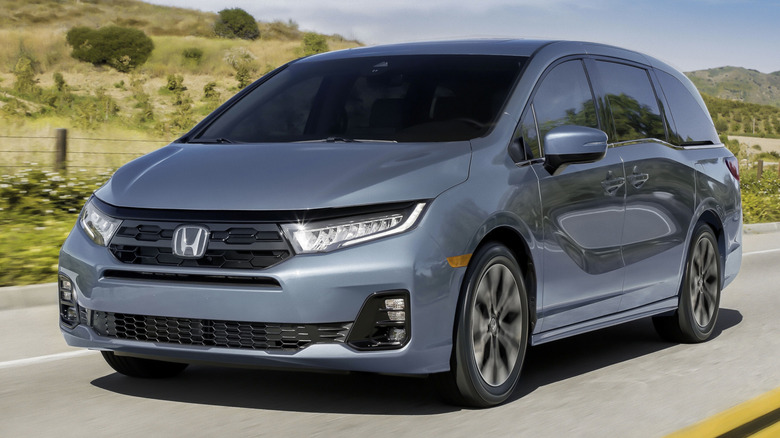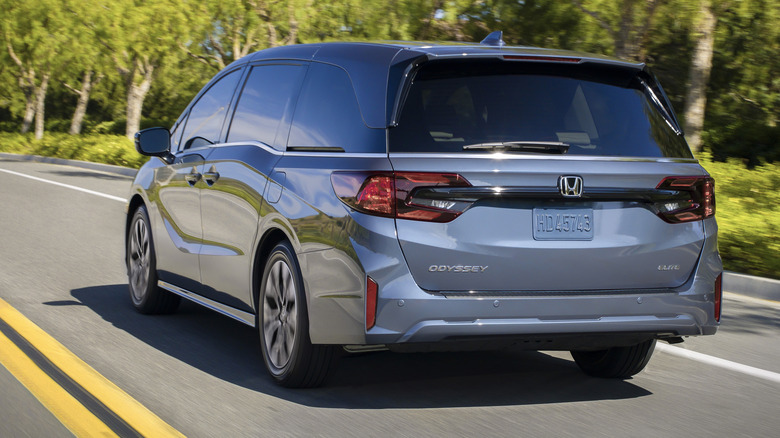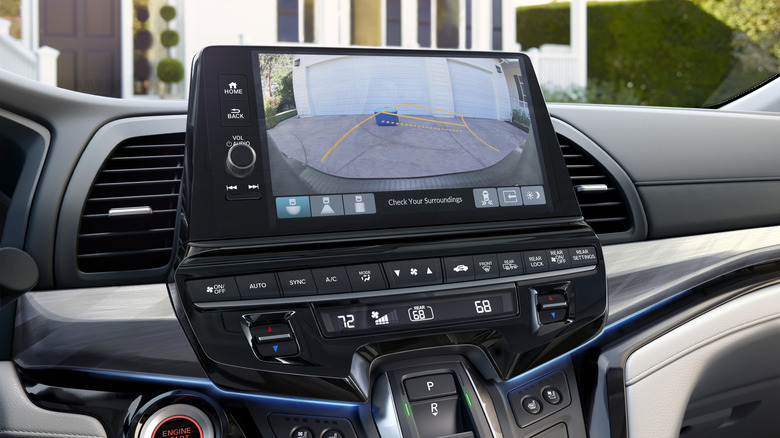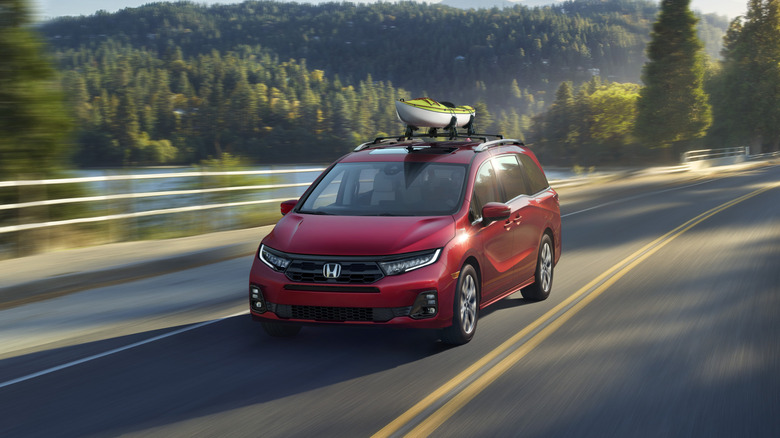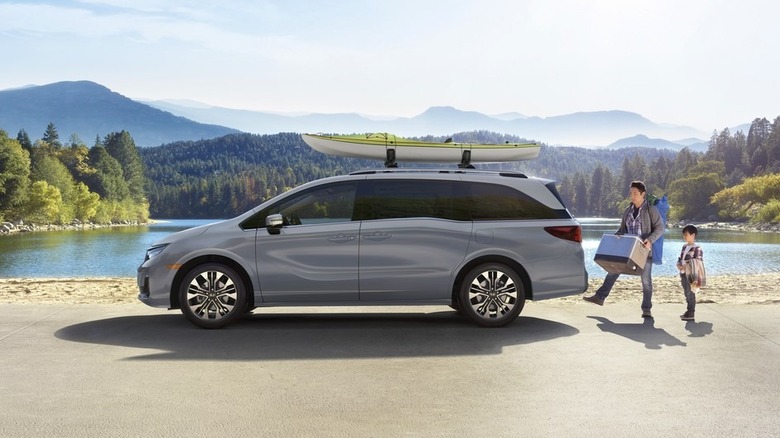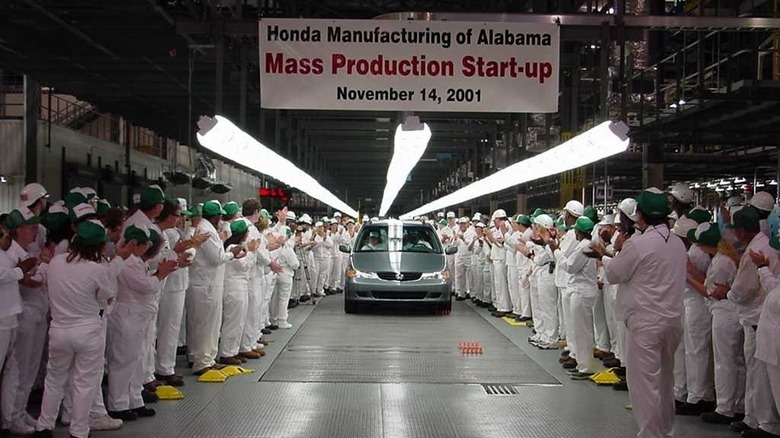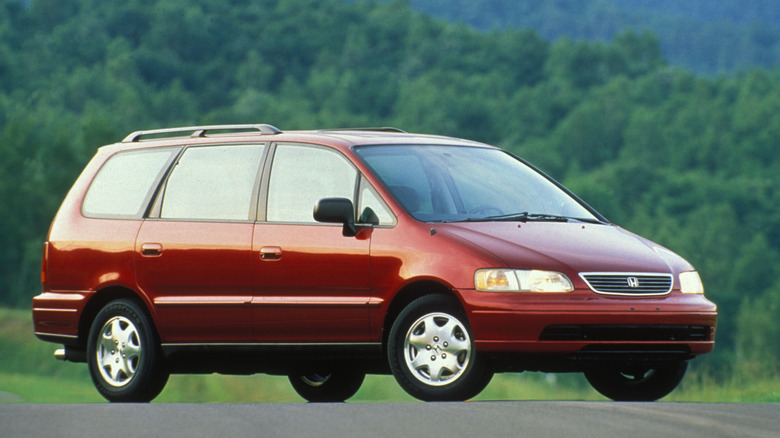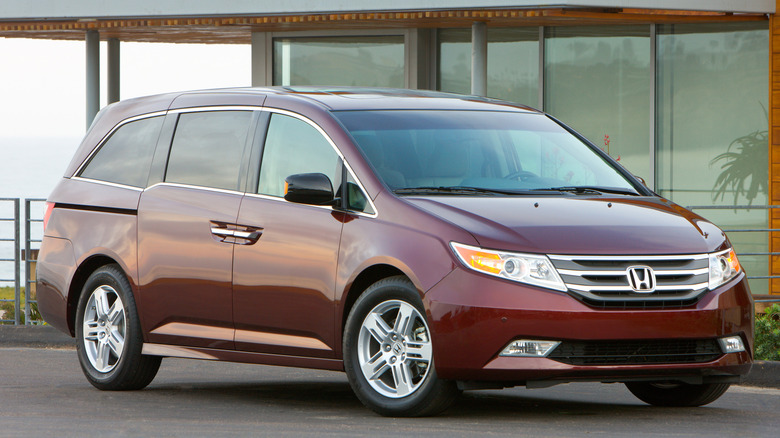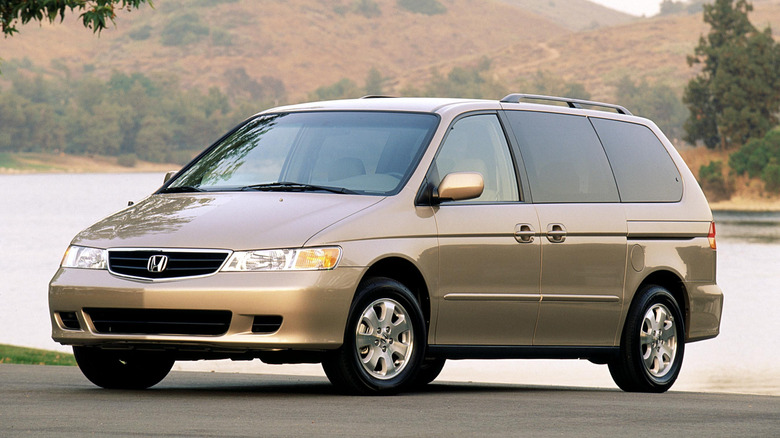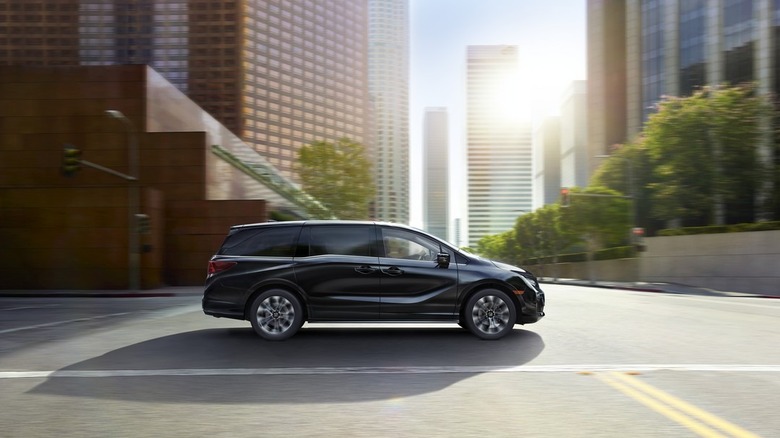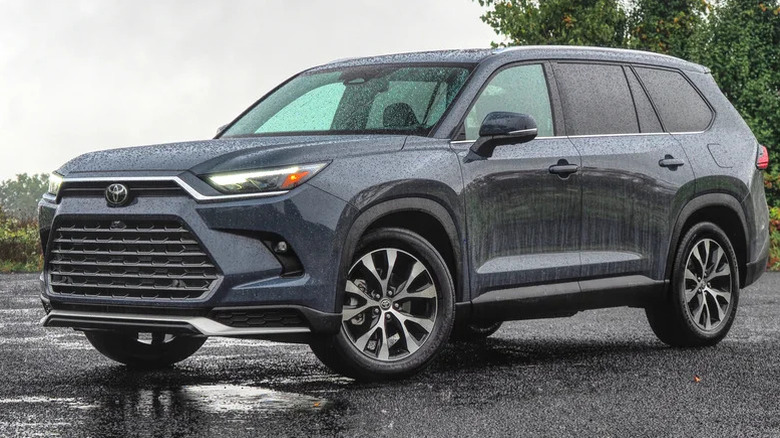10 Things To Know Before Buying A Honda Odyssey (New Or Used)
Minivans might not be as popular as they once were, but a few of the best-known minivan nameplates continue to sell in strong numbers. Honda sold roughly 72,000 examples of its Odyssey minivan in 2024 and around the same amount the previous year. Thanks to its consistent popularity with buyers, there is also a plentiful supply of used examples on the market, which means buyers can afford to be picky when it comes to finding the right example for them.
Across all of its five current generations, the core formula of the Odyssey has remained unchanged. It's designed to be a practical, sensible, and spacious family hauler, offering a range of trims and variants that stretch from budget-oriented to plush. The model is also reflective of Honda's brand-wide reputation for reliability, and in general, it's a safe bet to buy used. However, there are a handful of model years that don't live up to the high bar set by the model overall.
Whether you're looking to buy a new Odyssey or find a bargain used example, these 10 things are worth knowing about before you head to your nearest dealership.
The Odyssey starts from $42,220 for 2025
Buyers looking for a new Odyssey can pick from a range of trims for the 2025 model year, with the cheapest of those being the EX-L, which starts from $42,220 excluding fees. As standard, the base trim includes a power liftgate, a power moonroof and leather-trimmed seats, so it's far from spartan. The next step up in the range is the Sport-L trim, which adds unique interior accents and 19-inch black wheels for a starting price of $43,370.
The Touring trim is another step up again, costing at least $46,910 and featuring a number of additional extras on top of the standard equipment. Among these extras are a rear entertainment system to keep passengers occupied on longer trips, an in-cabin camera to more easily keep tabs on the rearmost row, and parking sensors.
Topping the 2025 Odyssey range is the Elite trim, which starts from $51,180 and adds upscale features like an 11-speaker audio system and heated and ventilated front seats.
Honda has made some changes for the 2025 model year
The current generation of the Odyssey minivan has been in production since 2018, but Honda has given it a makeover for 2025 to keep it feeling and looking fresh both inside and out. Among the changes is a new, standard 9.0-inch infotainment touchscreen with wireless Apple CarPlay and Android Auto, plus the aforementioned rear entertainment system that's available on the Touring trim and up. All trims also now receive a standard digital instrument display.
The other key change for 2025 is the Odyssey's exterior styling, which Honda's press release calls "a more premium, aspirational look" than before. We'll let you be the judge of whether it looks more premium, but it certainly helps bring the minivan's styling closer in line with other models in the brand's lineup. Unlike the latest incarnation of the 2025 Kia Carnival, Honda decided not to drastically reinvent the Odyssey's looks. As a result, it remains one of the more conservative-looking offerings in its segment.
The Odyssey's fuel efficiency is competitive, but not class leading
Much like Odyssey's styling, Honda has kept things traditional with the minivan's powerplant. Under the hood of every 2025 Odyssey sits the same 280 horsepower V6 engine as previous model years, with EPA-estimated fuel efficiency ratings of 19 mpg in the city, 28 mpg on the highway, and 22 mpg combined. That puts the Honda roughly on par with its gas-powered peers, but there are a few outliers in its class that offer significantly better figures.
The segment's standout performer in terms of efficiency is Chrysler's plug-in hybrid variant of the Pacifica, which achieves a combined 82 mpge with a full battery and 30 mpg combined on gas power alone. While it isn't a plug-in hybrid, the Toyota Sienna's standard hybrid powertrain also offers superior fuel-sipping credentials, with official ratings of 36 or 35 mpg combined depending upon whether power is sent to two or four wheels. The hybrid Kia Carnival can't quite match up to the best in class, but still offers 33 mpg combined.
Among non-hybrid rivals, the Odyssey compares more favorably. The non-hybrid Carnival achieves an EPA rating of 21 mpg combined, marginally less than the Honda, while the non-hybrid, all-wheel drive Pacifica can only manage 20 mpg combined. The Chrysler Voyager, which returns for the 2025 model year, matches the Odyssey with a 22 mpg combined rating. Still, the Honda remains a solid minivan for buyers looking for a tried-and-tested powertrain as opposed to class-leading efficiency.
A new Odyssey should retain around half its value after five years
Virtually all new cars will depreciate to some degree over their working lives, although inevitably some lose value faster than others. According to data from KBB, the Odyssey performs better than many of its segment rivals, and should retain 47% of its value after its first five years on the road. That's significantly more than the Kia Carnival, which is forecast to retain 40.9% of its sticker price, and the Chrysler Pacifica, which should keep only 40.5% of its initial value.
Only the Toyota Sienna manages to keep a higher proportion of its original value over the same period, with a KBB-estimated resale value of 50.5% of sticker after five years. Of course, these figures are only averages, which means that varying mileage, condition, and accident history all play a significant role in determining what you can expect to get back for any older vehicle when it's time to upgrade.
The Honda Odyssey is made in America
Since the beginning of President Trump's second term, the looming threat of tariffs has cast a significant shadow over the automotive industry and threatened to destabilize the American market. Some manufacturers look to be worse hit than others, although at the time of writing, the exact implementation of tariffs and their expected duration remains unclear.
Although it uses a mix of locally-sourced and global parts, the Odyssey should be shielded from the worst impacts of the proposed tariffs, as it is manufactured at Honda's assembly plant in Alabama. Its engine is also built in Alabama, while its standard 10-speed automatic transmission is built in Georgia.
A number of rival minivans are built outside of the U.S. and so are more likely to be subject to tariffs. The Chrysler Pacifica and Voyager are currently built at Stellantis' plant in Windsor, Canada, while the Kia Carnival — like the whole of the brand's lineup aside from the Telluride, Sportage, Sorento, and EV9 — is also imported. The Toyota Sienna is the only other domestically made minivan alongside the Odyssey, being built in Indiana.
The first Odyssey arrived in 1994
The original generation of the Odyssey had an unlikely start, having been conceived as a skunkworks project that was worked on outside of official company hours. It was thanks to the determination of Kunimichi Odagaki, the chief engineer at Honda's R&D Center, that it entered production at all.
Neither Japanese or American Honda divisions were originally interested in the idea, but Odagaki and his small team kept developing the minivan prototype until eventually they drummed up enough support to greenlight production. The first generation Odyssey arrived in 1994, and its success was a lifeline for Honda's Sayama plant in Japan, which has seen declining demand for its other models.
The minivan sold well both in America, which was the market for which it was originally designed, and in Japan. Soon, extra production capacity was needed to keep up with the demand for the car, and so Odyssey production was shifted to Honda's Canadian facility with the launch of the second generation car in 1998. After a facelift for the 2002 model year, the Odyssey began production at a different, newly-built plant in Alabama, where it continues to be made today.
The minivan has been through five generations to date
The first generation of the Odyssey represented uncharted territory for Honda, which had never made a minivan before. The second generation followed the same design principles and proved to be a hit with buyers, and so by the time the third generation was launched in 2005, Honda wasn't keen to mess with a working formula. This new generation brought a new, more versatile seating design, an upscale Touring trim with more premium features, and various tech and efficiency improvements to help the Odyssey stay ahead of its competitors.
By the time that the fourth generation appeared in 2011, the automotive market had changed once again, and the model's sales figures had dropped significantly from its all-time peak in the mid-2000s. Still, Honda managed to sell over 100,000 examples of the van each year in the U.S. alone, no doubt helped by the revised styling and improved efficiency of the new model.
The fifth and current generation of the Odyssey was first shown off at the 2017 North American International Auto Show and launched for the 2018 model year. New, revised infotainment tech was one of the biggest selling points, alongside new active safety tech such as lane keeping assist and a pre-collision automatic braking system.
Some Odyssey model years are worth avoiding
While most model years of the Honda Odyssey have proven to be reliable family haulers, a few are worth steering clear of. The 2002 and 2003 Odyssey models are particularly notorious, as these years hold the highest number of owner complaints on the NHTSA's database.
Their Achilles' heel is their transmissions, which are known to be prone to premature failure. According to complaints made to the NHTSA, sometimes that failure occurred suddenly while the driver was traveling at speed, although others saw a more gradual decline. Honda acknowledged the issue and announced a recall for the car in 2004, but issues have continued to be reported for years afterwards.
The 2005 and 2007 model years of the Odyssey also suffer from elevated levels of complaints, while the 2000 model rounds out the top five list of worst offenders. Other model years have their own quirks and weaknesses, so it's worth checking owners' forums for a more detailed overview of any given model year's known issues before you consider purchasing a used Odyssey.
The Odyssey's expected lifespan is among the longest on the market
If you stay away from the most problematic model years, the Odyssey is one of the longest lasting cars on the market on average. A wide-ranging study by iSeeCars ranked the Odyssey as the 16th best vehicle across the entire automotive market for expected lifetime mileage, averaging around 236,000 miles. That was enough to make it the second best in the minivan segment, behind only the Toyota Sienna.
Mileage is far from the only important factor to consider when purchasing a used car. In fact, condition is usually more important than either mileage or age alone, but it's always a good sign when a model has proved its capability of hitting high mileage figures consistently.
If you're on a tighter budget and thus considering a higher mileage or older example of the Odyssey, it's worth looking for all the same red flags as you should with any used car. Checking for signs of rust is always a good place to start, and particularly any signs that rust has been covered up. Checking for water leaks, cracks in the frame, and oil or coolant leaks is also worthwhile, as any of those issues can lead to a car needing costly repairs in the future.
There are plenty of alternatives to the Odyssey
Before heading to a dealership or a used car lot to pick up an Odyssey, it's worth considering what alternatives are also available within your budget. We've briefly discussed the current crop of rival minivans above, but buyers looking for an older used model could also consider now-discontinued options like the Dodge Grand Caravan or Kia Sedona.
One of the main drawbacks to the current generation Odyssey is its lack of electrification, which leaves it thirstier than some of its rivals. The Chrysler Pacifica Plug-In Hybrid is the clear winner for efficiency, although its reliability is a concern — our loaned Pacifica actually broke down before the end of our scheduled test week and had to be towed away on a flatbed truck.
As well as looking at the Odyssey's minivan rivals, it's also worth considering whether a roomy three-row SUV might be a better fit. Models like the Toyota Grand Highlander offer similarly cavernous interiors to Honda's minivan, as well as on-trend SUV styling and improved efficiency. The Mazda CX-90 is another worthy competitor, with much better driving dynamics than virtually all other cars of its size, albeit with the compromise of a slightly less generously sized third row.
